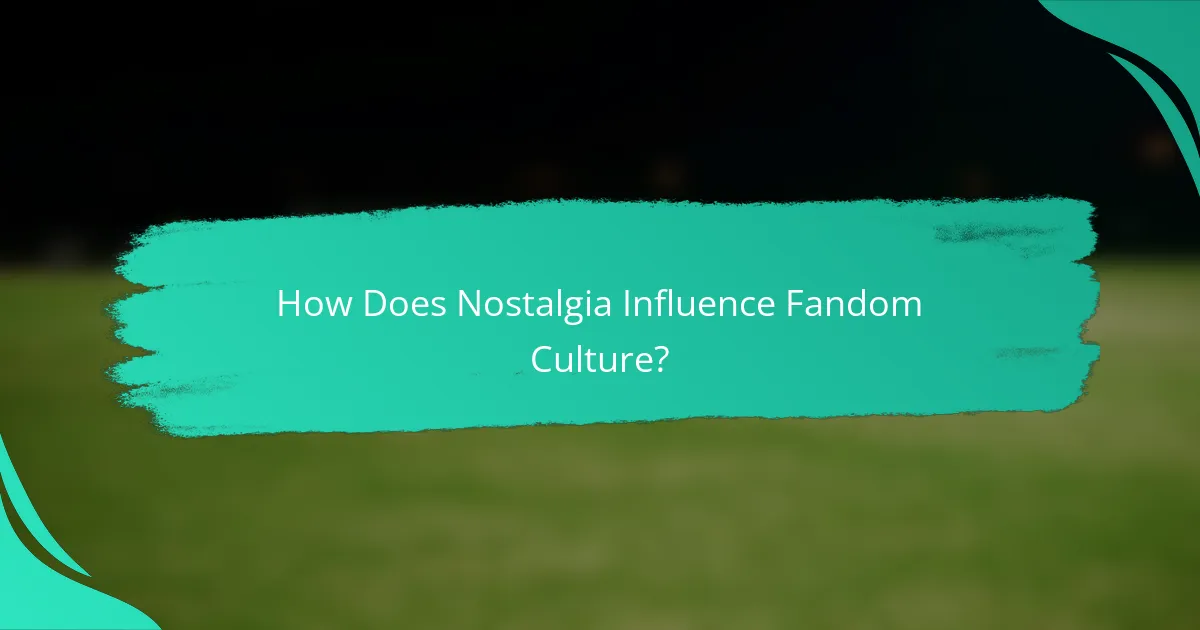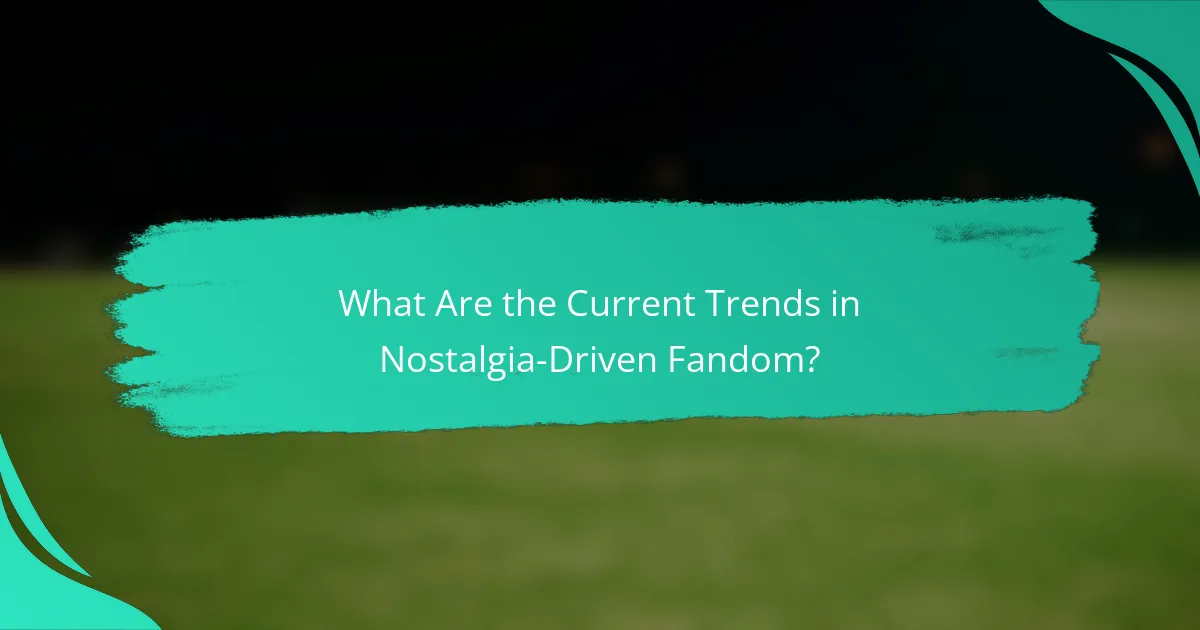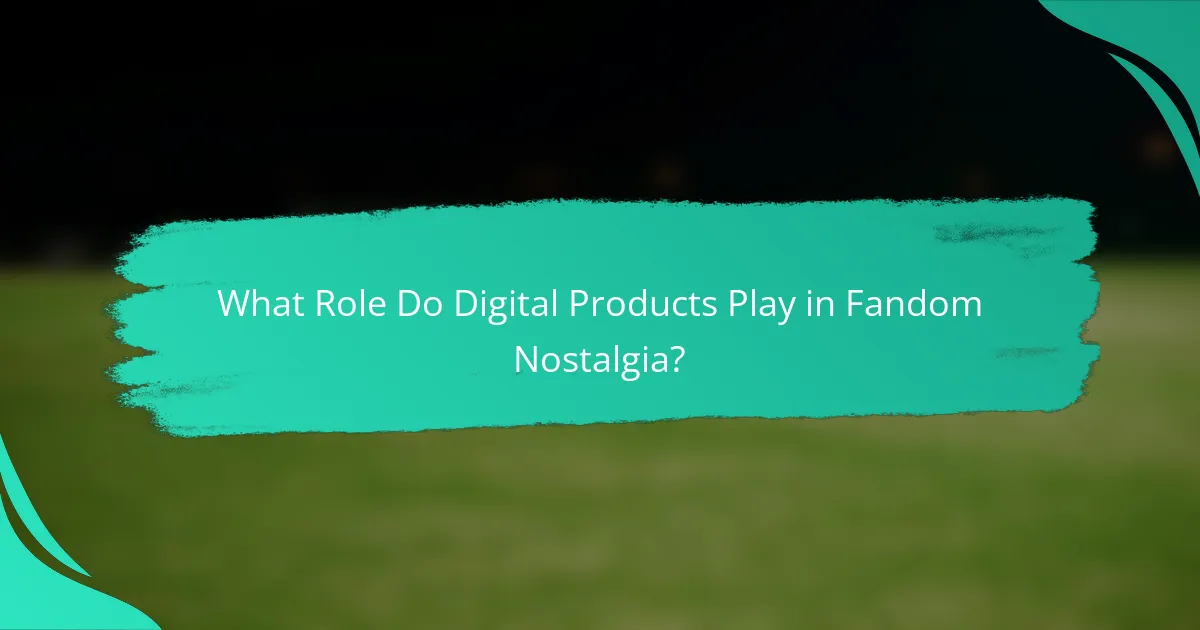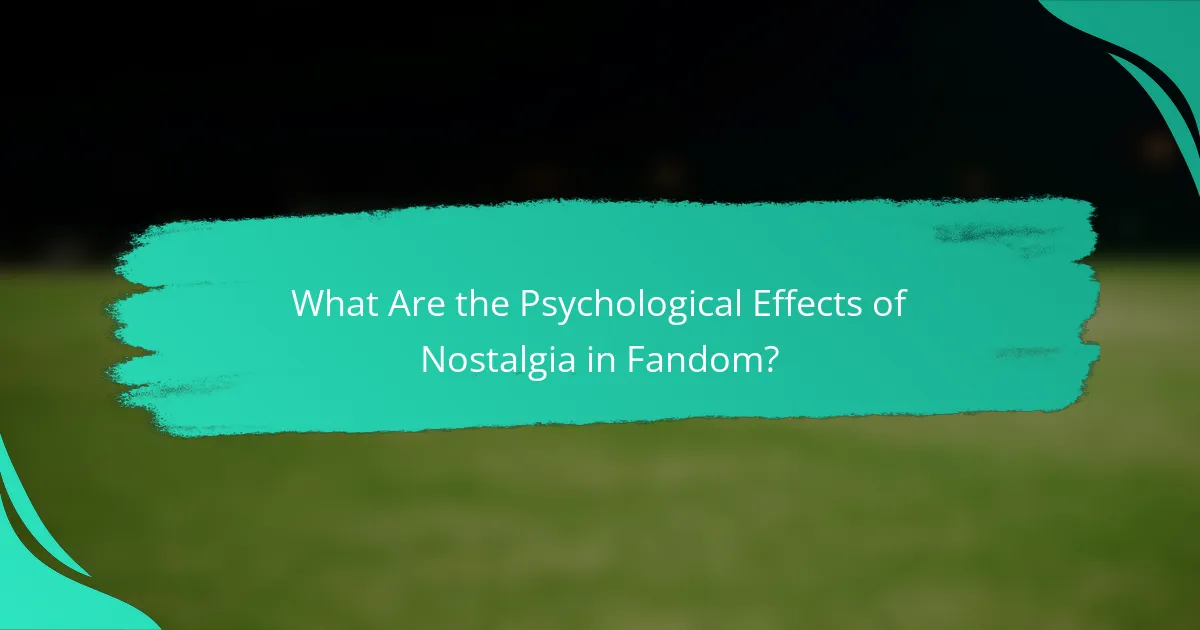Nostalgia plays a crucial role in shaping fandom culture, creating deep emotional connections among fans and fostering a sense of community. As different generations engage with media from their formative years, they bond over shared memories, leading to a resurgence of interest in retro content and vibrant interactions across various platforms.

How Does Nostalgia Influence Fandom Culture?
Nostalgia significantly shapes fandom culture by fostering emotional connections and enhancing community engagement. Fans often bond over shared memories of beloved media, which can lead to a vibrant culture centered around these experiences.
Emotional connections to media
Fans often develop deep emotional ties to media that evoke nostalgia, such as classic films, TV shows, or video games from their childhood. These connections can create a sense of belonging and identity, as individuals reminisce about the feelings and experiences associated with these works.
For example, a popular animated series from the 90s may spark fond memories for those who grew up watching it, leading to discussions and fan art that celebrate those cherished moments. This emotional resonance can also drive fans to revisit these works, reinforcing their attachment.
Impact on community building
Nostalgia plays a crucial role in community building within fandoms, as shared experiences create common ground among fans. Online forums, social media groups, and fan conventions often thrive on discussions related to nostalgic content, allowing individuals to connect over their mutual interests.
Communities may organize events, such as screenings or themed meetups, to celebrate their favorite media, further strengthening these bonds. Engaging in these activities fosters a sense of unity and belonging, which is essential for a thriving fandom culture.
Role in merchandise sales
Nostalgia can significantly boost merchandise sales, as fans are often willing to spend on products that remind them of their favorite media. Collectibles, apparel, and memorabilia tied to nostalgic franchises frequently see strong demand, especially during anniversaries or reboots.
For instance, limited edition items from a beloved series can sell out quickly, reflecting the emotional investment fans have in those properties. Brands can capitalize on this by creating targeted marketing campaigns that evoke nostalgia, appealing directly to the sentiments of their audience.

What Are the Current Trends in Nostalgia-Driven Fandom?
Current trends in nostalgia-driven fandom highlight a resurgence of interest in past media, driven by emotional connections and cultural references. Fans are increasingly engaging with retro content through various platforms, creating a vibrant community around shared memories and experiences.
Revival of retro franchises
The revival of retro franchises is a significant trend in fandom culture, with many classic movies, TV shows, and video games being reintroduced to new audiences. This often includes remakes, reboots, and sequels that tap into the original’s fanbase while attracting younger viewers. Examples include the return of series like “Stranger Things,” which draws heavily on 1980s pop culture.
These revivals can lead to increased merchandise sales and renewed interest in original content. Companies often leverage nostalgia by offering limited-edition products or special releases that appeal to both old fans and newcomers.
Social media nostalgia trends
Social media plays a crucial role in nostalgia-driven fandom, as platforms like TikTok and Instagram allow users to share and celebrate memories from their childhood. Hashtags related to nostalgic themes often trend, creating a sense of community among users reminiscing about past experiences. This can include everything from fashion trends to iconic TV moments.
Engagement through memes, challenges, and throwback posts fosters a collective memory that strengthens emotional connections to the content. Brands are increasingly participating in these trends to connect with audiences on a deeper level, often leading to viral moments.
Influence of streaming platforms
Streaming platforms have significantly influenced nostalgia-driven fandom by providing easy access to classic content. Services like Netflix, Hulu, and Disney+ offer extensive libraries of retro shows and films, making it simple for fans to revisit their favorites. This accessibility has sparked renewed interest in older franchises and has led to discussions about their cultural impact.
Additionally, streaming platforms often create original content that pays homage to past works, further blending nostalgia with contemporary storytelling. This strategy not only attracts older viewers but also introduces younger audiences to beloved classics, fostering a multi-generational fanbase.

How Do Different Generations Experience Nostalgia in Fandom?
Different generations experience nostalgia in fandom through their unique cultural references and emotional connections to media from their formative years. Millennials often reminisce about the 90s, while Gen Z finds comfort in early 2000s content, shaping their fandom identities and community interactions.
Millennials and 90s pop culture
Millennials, born roughly between 1981 and 1996, often reflect on 90s pop culture, which includes iconic TV shows, music, and toys. Series like “Friends” and “The Fresh Prince of Bel-Air” evoke strong feelings of nostalgia, influencing their preferences in current media.
This generation tends to engage with fandom through social media platforms, sharing memes and discussions about 90s references. Merchandise from this era, such as Funko Pop figures of beloved characters, remains popular among Millennials, reinforcing their emotional ties to the past.
Gen Z and early 2000s references
Gen Z, born from the late 1990s to the early 2010s, often looks back fondly on early 2000s media, including shows like “The Office” and movies like “Mean Girls.” This nostalgia is frequently expressed through TikTok trends and viral challenges that incorporate references from that time.
As digital natives, Gen Z connects with their fandoms online, creating content that celebrates their favorite early 2000s moments. The resurgence of fashion and aesthetics from this period highlights their desire to relive and share these experiences with others.
Comparative analysis of generational preferences
Millennials and Gen Z exhibit distinct preferences in their nostalgic fandoms, shaped by the media they consumed during their youth. While Millennials often gravitate towards sitcoms and music from the 90s, Gen Z shows a preference for reality TV and internet culture from the early 2000s.
Both generations utilize social media to express their nostalgia, but the platforms and formats differ. Millennials may prefer Facebook groups and Instagram posts, while Gen Z favors TikTok videos and Snapchat stories, showcasing their nostalgia in dynamic and interactive ways.

What Role Do Digital Products Play in Fandom Nostalgia?
Digital products significantly enhance fandom nostalgia by providing interactive and immersive experiences that allow fans to reconnect with their favorite franchises. These products, ranging from online communities to digital collectibles, create avenues for engagement and emotional connection.
Online communities and fan engagement
Online communities serve as vital hubs for fan engagement, fostering connections among individuals who share similar interests. Platforms like Reddit, Discord, and dedicated fan forums enable fans to discuss, share, and celebrate their nostalgia, often leading to the creation of fan art, fan fiction, and collaborative projects.
Participating in these communities can deepen emotional ties to the content, as fans collectively reminisce about their experiences and share personal stories related to their favorite shows, movies, or games. Engaging actively can enhance feelings of belonging and validation within the fandom.
Digital collectibles and NFTs
Digital collectibles, including non-fungible tokens (NFTs), have emerged as a popular way for fans to own a piece of their beloved franchises. These unique digital items can represent artwork, music, or moments from shows, allowing fans to express their nostalgia in a tangible way.
While investing in NFTs can be exciting, it’s essential to consider the volatility of the market and the potential for fluctuating values. Fans should approach purchases with caution, focusing on items that hold personal significance rather than solely on potential resale value.
Streaming services and nostalgic content
Streaming services play a crucial role in delivering nostalgic content, making it easily accessible for fans to revisit classic shows and movies. Platforms like Netflix, Hulu, and Disney+ often curate collections that highlight beloved titles from the past, catering to audiences seeking a trip down memory lane.
When selecting content to watch, fans should explore curated lists and recommendations that align with their interests. Additionally, many services offer features like watch parties, allowing fans to enjoy nostalgic content together, even if they are miles apart, enhancing the communal experience of nostalgia.

What Are the Psychological Effects of Nostalgia in Fandom?
Nostalgia in fandom can evoke strong emotional responses, enhancing feelings of connection and belonging among fans. It often serves as a coping mechanism, allowing individuals to revisit cherished memories and experiences associated with their favorite media.
Enhancement of social bonds
Nostalgia fosters social bonds by creating shared experiences among fans. When individuals reminisce about beloved shows, movies, or games, they often engage in discussions that strengthen their connections with others who share similar interests.
Participating in fandom communities, whether online or in-person, allows fans to form friendships based on mutual nostalgia. These interactions can lead to lasting relationships, as fans bond over their shared love for specific characters or storylines.
Impact on mental well-being
The psychological effects of nostalgia can significantly enhance mental well-being. Engaging with nostalgic content can provide comfort, reduce feelings of loneliness, and even alleviate symptoms of anxiety and depression.
Research suggests that nostalgia can boost mood and increase feelings of self-worth. By reflecting on positive memories, fans can cultivate a sense of identity and purpose, which contributes to overall emotional health.
